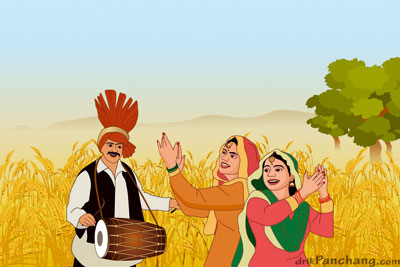April (Chaitra-Vaishakh)
Mahavir Jayanti

Mahavir is the last and the greatest Tirthankar of the Jain religion, and Mahavir Jayanti is the birth anniversary of Lord Mahavira, the 24th Tirthankara. Mahavir Jayanti is celebrated in the first day of Bhadrapad, when there is a grand cradle procession, and a general celebration of the auspicious day.The two sects of Jainism, Svetambaras and Digambaras, however, do not come to a consensus on the date of His birth. According to the Digambara sect, his birth took place in 615 BC, whereas the Svetembaras claim that it occurred in 599 BC.Just before Mahavir was born, his mother had sixteen dreams. Mahavir was born at four in the morning, which is considered very auspicious in Jainism and Hinduism.
Mahaveer Jayanti is celebrated on Chaitra Shukla Trayodashi falling at sun rise. If Trayodashi gets extended up to two days and falls or does not fall during Sun Rise then Mahaveer Jayanti is celebrated on the first day.
Followers visit the temples and offer ceremonial bath, known as ‘abhishek’, to Mahavira’s idol. The temples are lavishly decorated with flags to mark the birth anniversary of Lord Mahavira. Majestic chariot processions are also carried out with the images followed by millions of devotees while chanting prayers. Traditional dishes are prepared on this particular day and alms are offered to the poor.
Vaishakhi]

Vasakhi is a festival celebrated in the Punjab region. The festival coincides with other festivals celebrated on the first day of Vaisakh, in some regions of India.Vaisakhi is especially important for the Sikh community as it marks the establishment of the Khalsa. More recently, this festival is also celebrated around the world by Sikh diaspora.The festival is also celebrated by Hindus and Buddhists for different reasons including the start of a new year. People in the Punjab Region regard Vaisakhi as a harvest festival and the Punjabi new year.
Vaisakhi is one of the three festivals chosen by Guru Amar Das Ji to be celebrated by Sikhs (the others being Maghi and Diwali which later gave rise to the festival of Bandi Chor Divas during the times of the sixth Guru Hargobind Sahib Ji).
The festival bears a great significance for Sikhs due to the fact that on the Vaisakhi Day in the year 1699, the 10th Guru of the Sikhs, Guru Gobind Singh laid down the foundation of the Panth Khalsa, that is the Order of the Pure Ones. It is also used as a celebration for those accepting the five Ks.
To mark the celebrations, Sikh devotees generally attend the Gurdwara before dawn with flowers and offerings in hands. Processions through towns are also common.
For Hindus in the Punjab region, Vaisakhi is the start of the new Solar year, and is celebrated with requisite bathing, partying, and worshipping.In Kerala, the festival is called ‘Vishu’. It includes fireworks, shopping for new clothes and interesting displays called ‘Vishu Kani’.In Assam, the festival is called Bohag Bihu, and the community organizes massive feasts, music, and dancing.
Swami Dayanand Saraswati founded the Arya Samaj on Vaisakhi, in 1875.
Apart from the Sikhs and Hindus, Vaisakhi is an important day for the Buddhists as well. The name is Vesakha, Vaisakha, Vesak or Wesak. It commemorates the Birth, the Awakening and the Enlightened Passing Away of Gautama Buddha who was born as prince Siddharta.
People of Punjab celebrate this festival to express the joy of cutting of crops. When Sun enters into Aries as per Nirayan system then festival of Vaishakhi gets celebrated next day morning after sun rise.
Anang Trayodashi

Lord Shiva explained rati about rebirth of kamdev in form of Praduman and also the importance of the Anang Trayodashi. Devotees who observe this vrat will get happiness, wealth and marital bliss.
After the self immolation of Sati in the Yagya of Daksha Prajapati, lord Shiva got very disturbed. He carried her dead body on his shoulder and started traveling. To finish the illusion of Sati, lord Vishnu fragmented her dead body. Then, lord Shiva got engaged in meditationKamdev decided to wake up Lord Shiva from from the trance. Kamdev succeeded and Samadhi of lord Shiva was broken. In turn, Kamdev lost his body. When all God told lord Shiva about Tarkasur, his anger came down and he realised his mistake.
Lord told Rati that kamdev is still alive but, he does not have a body. Lord Shiva asked her to wait till Trayodashi. He said, when Vishnu will take birth as Krishna, and then later Kamdev will be born as Praduman, son of Krishna.
During Anang Trayodashi vrat, devotees also worship Rati and Kama. During the puja people offer flowers and fruits to the God Shiva and perform Shodashopachara (16 step) puja. Grand celebrations will be performed at Kandarp Ishwar of Ujaain.
Kamdev is also known as Kandarp. Ujaain Kandarp Ishwar darshan is considered verymuch auspicious on this day. It is also belived that visiting this temple on anang trayodashi will attain moksha.
Hanuman Jayanti

Hanuman Jayanti or Hanumath Jayanti is celebrated to commemorate the birth of Hanuman, the Vanara god, widely venerated throughout India. It is celebrated on the 15th day of the Shukla Paksha, during the month of Chaitra (the Chaitra Pournimaa).
At the day of the Hanuman Jayanti celebration, all the Hanuman temples become full of crowd as people start puja from the early morning after a holy bath. Hanuman Jayanti is celebrated with great enthusiasm by the people of the Hindu religion as an important festival of the Hindus.People worship Lord Hanuman as a symbol of devotion, magical powers, strength and energy. People read Hanuman Chalisa as it has ability to conquer evil spirits and provide peace to the mind.
It is celebrated on the day of Chaitra Purnima. Tithi is determined on the basis of sun rise. If Chaitra Purnima gets extended up to two days and falls or does not fall during Sun Rise then it is celebrated on the first day. The devotees of Lord Hanuman visit Hanuman temples at this day after a holy bath in the early morning, apply red tilak (vermillion) to the foreheads of Hanuman idol, read Hanuman Chalisa, After puja, people apply red Sindur to their own foreheads as a Prasad and distribute laddoo Prasad among people to get blessed with what they have prayed to their God Hanuman.
Akshaya Tritiya
Akshaya tritiya is also called as ‘akhateej’. The word Akshaya means the immortal. Akshaya Tritiya is celebrated on the third tithi of brighter half in the lunar month Vaishakha. In Indian mythology Akshaya Tritiya has great importance This day is considered very auspicious for starting new projects auspicious for performing marriage ceremonies and for purchasing precious things. In Hindu mythology this day is considered as a mark of success and well-being. This day is also called the day of sarva siddhi day. This day can be chosen to perform auspicious ceremonies by anybody without consulting any astrologer. Akshaya Tritiya is also called Navanna Parvam. Akshaya Tritiya falling on a Rohini star Monday is considered more auspicious.
‘Nara Narayana’ also incarnated on this day. Lord Vishnu incarnated in the form of ‘Parashurama’ on this day. The doors of famous pilgrimage place ‘Badrinath’ also open for the darshan of devotees from this day after a gap of four months.
In Hinduism, Akshay Tritiya was the day when Vyasa started writing the history of the great Bharat war in the form of an epic Mahabharata. This day is symbolized by god Vishnu, the preserver-god in the Hindu Trinity. According to Hindu mythology, on this day the Treta Yuga began and the river Ganges, the most sacred river of India, descended to the earth from the heaven.It was on this day that Goddess Annapoorna devi was born.
Kubera received his wealth and position as custodian of wealth and property with Goddess Lakshmi on this day, by praying to Lord Shiva at Shivapuram.
It is traditionally observed as the birthday of Parashurama, the sixth incarnation of god Vishnu. In Mahabharata, Yudhishtira receives the Akshaya patra, which he uses to serve food for all the needy in his kingdom.It is on this day that poor Sudama, the best friend of Krishna visits Him (Lord Krishna) to greet Him after He became the King.It is on this day that Dushasana, Duryodhana’s brother, unveils Draupadi at the royal court where Krishna protects her providing the ‘unending’ veil.
Adi Shankara recited the Kanaka Dhara Stotr on this day for the sake of the poor couple at whose house he stopped for Bhiksha and was offered their only available gooseberry.
Goa and Kerala regions, even today, are referred to as Parushurama Kshetra. Akshaya Tritiya, the third day of the bright-half of the lunar month of Vaisakha is considered one of the most sacred days of the year.
In Odisha, on Akshay Tritiya day, farmers start ploughing their land and construction of chariots for Rath Yatra begins at Puri. In Bengal, on the day of the Akshay Tritiya, “HalKhata” – a ceremony to start the new audit book is performed – with the worship of Ganesha and goddess Lakshmi. In jat farming community. Early morning, a male member of a Jat family goes to the field with a shovel. All the animals and birds encountered on the way to the field are omens and predictions for rains and crops. Akshay Tritiiya is an occasion for weddings,
On Akshay Tritiya. A day-long Kubera Lakshmi Puja is performed in which an image of Lakshmi is worshiped with Sudarsana Kubera Yantra, symbolising Kubera. In more recent history, Adi Shankara recited the Kanaka Dhara Stotr on this day for the sake of the poor couple.This fast is observed on the Tritiya of bright half of Vaishakh. One should worship Lord Vishnu and Goddess Laxmi on this day. In the morning after having bath one should start worshipping God by offering leaves of basil (tulsi plant) with sugarcandy. Donate the favourite articles with oblation among the devotees. Donate barley on this day which is considered the king of grains. After that read Akshay Tritiya Vrata Katha. Chant following mantra 108 times on a Tulsi rosary.
